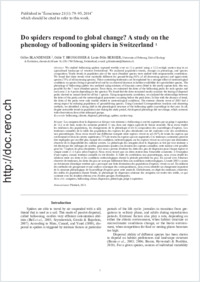Do spiders respond to global change? A study on the phenology of ballooning spiders in Switzerland
- Blandenier, Gilles Unit of Ecology & Evolution, Faculty of Science, University of Fribourg, Switzerland
- Bruggisser, Odile T. Unit of Ecology & Evolution, Faculty of Science, University of Fribourg, Switzerland
- Bersier, Louis-Félix Unit of Ecology & Evolution, Faculty of Science, University of Fribourg, Switzerland
-
01.03.2014
Published in:
- Écoscience. - 2014, vol. 21, no. 1, p. 79–95
English
We studied ballooning spiders captured weekly over an 11-y period using a 12.2-m- high suction trap in an agricultural landscape of western Switzerland. We analyzed population trends, changes in phenology, and species composition. Yearly trends in population size of the most abundant species were studied with nonparametric correlations. We found that these trends were markedly different for ground-living (92% of all decreasing species) and upper-strata species (75% of all increasing species). These contrasting tendencies can be explained by a stronger effect of meteorological conditions on species living at ground level and by an observed decrease in habitat availability for open-habitat species. The phenology of ballooning spiders was analyzed using mixtures of Gaussian curves fitted to the yearly capture data; this was possible for the 7 most abundant species. From these, we estimated the dates of the ballooning peaks for each species and each year (1 to 4 peaks depending on the species). We found that the dates remained mostly constant: the timing of dispersal peaks showed no annual trend for all but 1 species. Using nonparametric correlation, we analyzed the relationships between the dates of the peaks and the meteorological parameters occurring before the peak dates. In line with the absence of trend, the dates of the peaks were only weakly related to meteorological conditions. The extreme climatic event of 2003 had a strong impact by reducing populations of ground-living species. Using Canonical Correspondence Analysis and clustering methods, we identified a strong shift in the phenological structure of the ballooning spider assemblage in that year. In all, despite noticeable trends in population size during the study period, the dispersal phenology did not change, which contrasts with observations from other arthropod groups.
- Faculty
- Faculté des sciences et de médecine
- Department
- Département de Biologie
- Language
-
- English
- Classification
- Biological sciences
- License
-
License undefined
- Identifiers
-
- RERO DOC 287936
- DOI 10.2980/21-1-3636
- Persistent URL
- https://folia.unifr.ch/unifr/documents/305356
Statistics
Document views: 130
File downloads:
- pdf: 241
